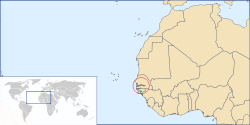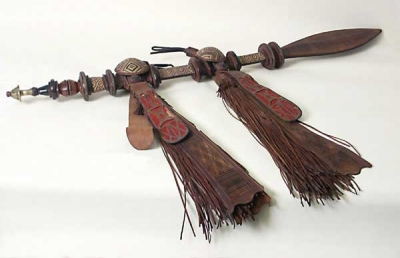Dress Sword (1929.12.3)
 GambiaDress sword from The Gambia, Africa. Collected by W. D. Canol and owned by George Scott. Given to the Museum by Mr. Scott's niece, Majorie T. Cam in 1929.
GambiaDress sword from The Gambia, Africa. Collected by W. D. Canol and owned by George Scott. Given to the Museum by Mr. Scott's niece, Majorie T. Cam in 1929.
This sword is a 'dress sword'. It was worn as a status symbol by a wealthy or high-status member of the Mandinka, a large ethnic community of West Africa. One way of concluding that it was never used in combat is due to the complete lack of guard for the hand.
The Art of War
This high-status sword from The Gambia demonstrates the widespread African practice of importing European sword blades and supplying them with a hilt and scabbard of local style. The blades of such Mandinka dress swords are usually are usually those of curved French cavalry sabres, reflecting the economic networks of European colonial influence. These swords were the exclusive prerogative of Mandinka men of importance or social standing and were intended to enhance their impressive and martial appearance.
The most significant artistic feature of the sword is the very high quality of dyed and woven leatherwork to be seen on the scabbard and baldrics (wearing straps). The result is particularly striking, and represents a strong culture of dyed, tooled and plaited leatherwork in much of West Africa. The geometric pattern of woven fibre is especially representative of decorative material culture in this region.
The flaring leaf-shaped lower portion of the scabbard is said to represent the head of a crocodile and can also seen on the scabbard of the straight kaskara sword of the Eastern Sudan, on the opposite side of the continent's Sudanic belt. Some scholars think the most plausible explanation for the unusual scabbard form appearing in two places over 3000 miles apart is that it was carried westward across the Sudan by successive waves of Islamic warriors over the last one thousand years





